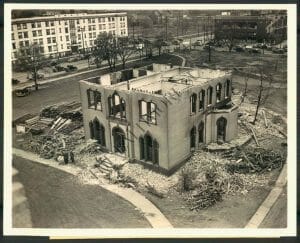Whatever happened to the wealth of Standard Oil magnate, John D. Rockefeller?
In spare moments, I’m collecting pictures and trivia about Cleveland, Ohio in 1910 for a future novel. As I poured over pictures of Millionaire’s Row, Euclid Avenue’s famed line-up of wealthy homes, I came across this picture of the demolition of John D. Rockefeller’s home on Euclid Avenue.

I found myself becoming wistful and philosophical. John D. Rockefeller, amassed a fortune worth over $400 billion in today’s terms. He is known to be the richest person in modern history. Yet in time, in spite of all that wealth, Rockefeller’s home was dismantled.
Wealth and notoriety are so tempting. There’s something within us that wants to grab all we can in this life. Homes become a status symbol of who we are and what we have. Perhaps we think the more we own, the more important we will look to others.
It all seems so silly. “You can’t take it with you!” we’re repeatedly told. This picture proves that what we leave behind will ultimately corrode and crumble. An inter-belt highway now graces the ground where Rockefeller’s home once stood. Only historians and archeologists remember the exact location of his home.
I remember the sadness of the fleeting moment. When I visited my hometown of Tucson, AZ about two years ago, I asked my aunt to drive past my family’s first home. We moved when I was three and I have two dim memories of the house. I wish I hadn’t. It was the junkiest of junky homes on the block. Sagging, trash filled, and neglected, it wasn’t a place I wanted to remember for the memories. If I wanted to be remembered for something, I decided, it wasn’t going to be in a house. Houses, like so many other material possessions, deteriorate.
I think Rockefeller knew that. My research of period houses quickly sidetracked to a study of the man, John D. Rockefeller. I found out that Rockefeller had several homes: two in Cleveland, a couple in New York, and one in Florida. My husband told me his father was the surveyor for the renovation of the home in Florida, known as The Casements. Rumor was that Rockefeller wanted the home destroyed upon his death, but his son sold the house to a widow lady. Several owners later, the house now in great disrepair, was sold to the city.
Jack, also bit by the curiosity bug, found out Rockefeller refused to give out autographs. An archaeologist, conducting a dig on Rockefeller’s “country home” Forest Hill, said her team was particularly looking for ceramics. Rockefeller, in spite of his wealth, was rumored to have lived modestly. Finding what china the family used in their home would prove or disprove the extent of living within modest means, the archaeologist said. I think I believe the bit about modest living. Here’s a picture of Rockefeller’s home in its heyday.

Compared to some of the other pictures of Gilded Age mansions I’ve collected, believe me, this is modest!
Now I was curious! I pulled up an article on Wikipedia about America’s richest man. Most of us know Rockefeller as the founder and CEO of Standard Oil. You might remember from high school history that the Supreme Court determined Standard Oil was in violation of anti-trust laws and forced the break-up of the company in 1911. That makes Rockefeller sound like a money-hungry maniac.
However, John D. Rockefeller was also known for defining the “modern structure of Philanthropy.” His fortune was spent not on lavish houses, but used to create foundations that would have “a major effect on medicine, education, and scientific research.” Wikipedia says that his foundations were instrumental in the scientific research leading to the eradication of hookworm and yellow fever. Rockefeller was also the founder of three Universities and one college, including one in the Philippines and a college for African American women in Atlanta, Georgia.
The next paragraph really caught my eye. Rockefeller was a faithful member of the Erie Street Baptist Mission church where he taught Sunday School and at various times, served as “trustee, clerk, and occasional janitor.” The richest man in America serving as a church janitor?? He was known for his abstinence from alcohol and tobacco. “Religion was a guiding force throughout his life, and Rockefeller believed it to be the source of his success,” says Wikipedia. Further in the article, Wikipedia notes that a Baptist minister once encouraged Rockefeller to make as much money as he could then give away as much as he could. Rockefeller did exactly that. At age sixteen he noted in his ledger his charitable giving of six percent. By age twenty, that amount was over ten percent. He retired early and spent the last forty years of his life devoted to his philanthropic work.

Now that’s a legacy worth remembering! It makes me think of Jesus’ words in His Sermon on the Mount:
“Do not store up for yourselves treasures on earth, where moths and vermin destroy, and where thieves break in and steal. But store up for yourselves treasures in heaven, where moths and vermin do not destroy, and where thieves do not break in and steal. For where your treasure is, there your heart will be also.” – Mt 6:19-21
Rockefeller used his wealth to do good for others. Yes, he had homes and probably lived more lavishly than you or I could ever imagine. But he kept it simple and focused on the good he could do. The legacy of his foundations lives on to this day.
What’s my legacy? Certainly not the size or contents of my home. Why bother? That’s not going to last any time at all. I like what James Dobson of Focus on the Family has said. His goal in life is to get to heaven and take as many people with him as he can.
When I focus on passing the torch of my faith, I am laying up treasures in heaven. I’m building structures that will last not just for generations but forever. Yes, my efforts may not be able to be seen by others. But what is seen so often crumbles into nothing. It’s the unseen that lasts.

And his son, John D. Rockefeller, Jr. was the main person responsible for the extensive restoration of Colonial Williamsburg.
As I read about Rockefeller, I wondered how much his descendants followed in his footsteps in his philanthropic work. Thanks for sharing this.
The site of the Rockefeller mansion pictured was located on the southeast corner of east 40th and Euclid and the property ran to Prospect Avenue. . There is an office building on the spot today. The family’s first Cleveland home was located on Cheshire street which later became East 19th street off Prospect Avenue. The street is no longer there.
Thank you for sharing this information. It is amazing to me how all those mansions on Millionaire’s Row are just gone not more than a century later.